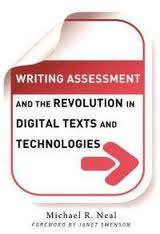Review Conversation
As I read the first few paragraphs of Chapter Six, I was struck by Neal's assertion that whatever side of technology usage on which we find ourselves, we must at least accept its pervasiveness within our students' daily lives. In doing so, we must then make another leap to recognize technology's part in our field's future. Neal offers two frameworks that he argues will help us to accomplish such tasks.
His solution takes form in dual frameworks of balanced, valid assessments for student writing. He develops his first idea of construct validity in terms of redefining validity itself. He turns from our traditional notion of validity as an either/or measurement of a test towards a revised idea of validity as a continuum measurement of decisions we make with assessments. This shift represents a fundamental change in the ways practitioners in our field view the act(s) of determining validity. To build on this shift, Neal then presents a third part of the framework: choices that instructors must make about appropriateness. Analyses of appropriateness require us to interrogate social and educational implications of choosing particular assessment technologies. In making validity claims, Neal argues that we must move beyond asking IF a test is valid and ask instead HOW the test impacts students' growth and success. He gives a relevant example of one such assessment, when he relates his personal experience as a writing assessment administrator for students who scored below a given number on the SAT. He insightfully notes demographic disparities among this group of students and uses his experience as a means of highlighting the realities of social inequities that occur in every assessment situation.
Neal's second assessment framework builds on his previous notions of connectivity and appropriateness. He uses lists of learning outcomes as starting points for conversations in our field to talk about linking the right technologies (hypertechs) with the right assessments. Again, it seems to come down to choices and evaluations of these choices. Here, the choices are informed by WPA outcomes and the local outcomes frequently associated with them. He channels Cheryl Ball in advocating use of WPA outcomes as jumping-off points for deciding which hypertechs will fit our students and class environments best. To illustrate his argument, Neal provides two questions that control operations in this framework: (1) Which existing outcomes are connected to a proposed assessment hypertech; and (2) what obstacles need to be overcome to implement the chosen hypertech. In explicating Question Two, he offers examples of obstacles as non-human barriers: access issues, technological breakdowns, and infrastructure. In addition, he classifies human constraints and stakeholder resistance as further challenges to implementation of this framework. Neal's call to us as instructors and administrators (I would add students as well) is to anticipate where obstacles and challenges will come.
